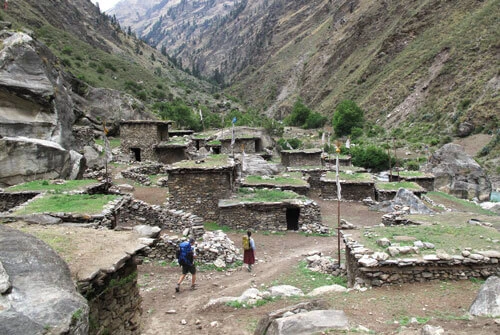Reverse Altitude Sickness is Still a Medical Mystery:
You may have just experienced reverse altitude sickness, also known as High Altitude De-Acclimatization Syndrome (HADAS). Don't worry, you probably haven't heard of it before - it's vague and rarely discussed. But for adventurers who play at height, it's good to know the risks before rapidly descending into hazardous lower altitude. Here’s what you should know about this unusual sickness of the Lower Altitudes.
Despite periodic appearances in mountaineering history, reverse altitude sickness remains murky. The exact mechanisms behind it stay unknown, with several theories under debate:
- Cerebral Edema: Some research points to extracellular fluid accumulating in the brain after initial ascent, then suddenly shifting location upon descent.
- Oxygen Toxicity: Possible that acclimatized climbers get "addicted" to thin air, and then suffer toxicity symptoms when oxygen spikes during descent.
- Blood Pressure Confusion: Dramatic blood pressure increases during exertion at altitude and may overcorrect when dropping in elevation.
- Physiologic Backlash: Intense summit efforts may deplete physiological reserves, causing illness soon after.
So while the riddle of reverse altitude sickness hasn't quite been solved, one key lesson rings clear...
What goes up, must come down. But slowly, safely, and ever vigilant about the risks high places still hold, even on the descent.
What is Reverse Altitude Sickness or Low Altitude Sickness (HADAS)?
To understand reverse altitude sickness, you first need to understand regular AMS or altitude sickness. Altitude sickness is a condition that can occur when ascending into higher elevations, usually above 8,000 ft (2,400 m). It’s caused by low oxygen levels and atmospheric pressure at higher elevations. Symptoms can include headaches, nausea, fatigue, and trouble sleeping. In severe cases, it can progress to life-threatening fluid buildup in the lungs or brain.
Reverse altitude sickness essentially works in the opposite direction. Instead of illness setting in as you climb upward, symptoms start when coming back down from a higher elevation. Experts theorize it's related to physiologic changes and blood oxygen fluctuations that happen during rapid descent.
What are the Symptoms of HADAS?
Many symptoms of reverse altitude sickness mirror acute mountain sickness (AMS) on ascent:
- Fatigue
- Nausea and vomiting
- Shortness of breath
- Lightheadedness
- Headaches
- Unable to walk straight (ataxia)
- Altered mental status
- Frequent urination
However, some unique symptoms also occur:
- Profound weakness and collapse
- Lethargic and Drowsy
- Severe vertigo
- Vision changes
These symptoms appear rapidly and generally show up at elevations between 8,000-12,000 ft (2,400-3,600 m) on descent. In severe cases, loss of consciousness or coma can even occur.
Who's At Risk?
Reverse altitude sickness is uncommon, but certain groups face higher risk:
- Recent Arrivals: Those new to a higher elevation are more susceptible to descent. Symptoms generally appear in the first 36 hours after arriving above 8,000 ft (2,400 m) from 5000+ meters.
- Fast Descenders: Quickly coming down more than 3,000 ft (915 m) seems to increase risk significantly. Slow and gradual descents are safer.
- Previous AMS Sufferers: Those with a history of acute mountain sickness on ascent have higher odds of experiencing symptoms on the way down too.
- Young, Fit Men: For unknown reasons, men under 50 years old make up the majority of HADAS cases. Overexertion combined with rapid descent may play a role.
Why Reverse Altitude Sickness is Dangerous?
Unlike altitude sickness like AMS, HACE, and HAPE, reverse altitude sickness often catches people by surprise for a few key reasons:
- Letting Guard Down: After summiting safely, many hikers overlook altitude safety during descent. But additional physiologic stresses make this period risky too.
- Overexertion: Climbers often push extremely hard for summit bids. Shortly they rush to get back down to a safer camp or to a place where they can celebrate their achievement. This combination of quick descent and overexertion results in HADAS susceptibility.
- Mild Hypoxia:It is certainly very dangerous to rush down without setting much ground for your body to re-acclimatize. Many trekkers and Climbers have experienced mild hypoxia on quick descent.
- No Safety Nets: On our high-altitude expeditions we usually have Acclimatization days offering enough time for our body to adapt. However, we often pay zero attention to re-acclimatize on our descents which results in reverse altitude sickness attacks.
High-Altitude Heroes: Famous Victims
While not well known to the average hiker, reverse altitude sickness has stricken its fair share of famous mountaineers over the years:
- Edmund Hillary: After surviving extreme cold and thin air to achieve the first summit of Mt Everest with Tenzing Norgay in 1953, Hillary came down with reverse altitude sickness around 23,000 ft (7,000 m). He attributed his survival to the care of teammates and porters.
- Reinhold Messner: In 1978, this legendary Italian climber nabbed the first oxygen-free ascent of Everest with Peter Habeler. Safely down from the summit, Messner collapsed just above 26,000 ft (8,000 m) on the descent, likely from HADAS.
- Will Cross: In 2009, Briton Will Cross set the speed record for scaling the highest peak on each continent. But after a victorious climb up Denali in Alaska, he developed HADAS on the descent. Vision problems, ataxia, and breathing issues landed this peak-bagger in the hospital.
Workers on the Highest Motorable roads in the world:
There have been records of incidents where it has been reported that workers working on the highest motorable roads in the world suffered from HADAS. For example, workers at the Umling La Pass in Ladakh, India, which sits at an elevation of 5,883 meters (19,300 feet), have endured HADS during their rapid descent to lower elevations in the winter months.
Similarly, reverse altitude sickness has afflicted individuals driving through the Mana Pass (also called Dungri La) in Uttarakhand, India. At 5,610 meters (18,406 feet), the high point of this mountain pass can trigger symptoms of HADS in people making the steep descent towards lower ground.
In both cases, the abrupt change to a new elevation causes physiological stress. where the body struggles to adapt quickly enough. As opposed to altitude sickness that manifests during ascension, Low altitude Sickness surfaces when rapidly transitioning from a very high elevation to a meaningfully lower one.
First Aid for HADS or Low Altitude Sickness
If signs of reverse altitude sickness appear in you or someone on your team, act quickly and decisively:
- Stop Descent: Stop as soon as possible and Res. Further descent is dangerous until the person acclimatizes. Try to stop above 8,000 ft (2,400 m) if possible.
- Check Vitals: Monitor breathing rate and quality, use Pulse Oximeter to check oxygen saturation and pulse, and other vitals. Give supplemental oxygen if available.
- Keep Warm: Insulate the person with warm layers and shelter.
- Hydrate and Refuel: Offer fluids and carbohydrate-rich foods.
If symptoms persist or worsen, very slowly continue descent in case full de-acclimatization is needed. But never rush it!
- Evacuate: For severe symptoms (altered mental function, ataxia, coma, etc.), arrange emergency evacuation. Descending may not help, so move horizontally to avoid fatality.
Come Down Slowly: Prevention Tips
While not guaranteed to ward off reverse altitude sickness, certain preparatory and descent measures can help reduce your risk:
- Gradual Descend: Take a slow and steady approach while descending with a better re-acclimatization process. Losing elevation faster than 1,000 ft (300 m) per hour significantly raises risk.
- Avoid Overexertion: Don’t push too hard while descending trying to set new speed records. Give time to your body to re-adjust, don’t rush.
- Stay Hydrated: Drink plenty of fluids during descent to counteract breathing moisture loss in dry mountain air. Provide your body with some soothing rest.
- Mind the Symptoms: Recognize signs of reverse altitude sickness promptly. The faster you respond, the better the outcome.
Conclusion
Reverse Altitude Sickness, or High Altitude De-Acclimatization Syndrome, poses a unique challenge to individuals descending rapidly from high elevations. Understanding its causes, symptoms, and preventive measures is crucial for ensuring a safe transition from high to lower altitudes.
Awareness of HADAS symptoms is crucial for individuals undertaking rapid descents. Recognizing signs early allows for prompt intervention and reduces the severity of the condition.
Emphasizing safety measures during both ascent and descent in high-altitude environments is essential to prevent and manage Reverse Altitude Sickness effectively.
FAQs About Reverse Altitude Sickness or Low Altitude Sickness:
1. Can Reverse Altitude Sickness occur in anyone descending from high altitudes?
Reverse Altitude Sickness can affect anyone, but susceptibility varies based on individual factors like age and physical condition.
2. What steps can one take to prevent Reverse Altitude Sickness?
Gradual descent, proper hydration, nutrition, and awareness of symptoms are key preventive measures.
3. Is Reverse Altitude Sickness life-threatening?
While usually not life-threatening, severe cases may require medical intervention for symptom management.
4. How long does it take for symptoms of Reverse Altitude Sickness to appear after descent?
Symptoms can manifest within hours of rapid descent but may vary in onset time among individuals.
5. Can Reverse Altitude Sickness be completely avoided?
While it's challenging to completely avoid, taking gradual descent measures and being aware of symptoms significantly reduce its impact.
ALSO READ:
- PREVENTION OF HIGH ALTITUDE SICKNESS IN NEPAL
- COMMON MEDICAL ISSUES WHILE TREKKING IN NEPAL AND ITS PREVENTIONS
- ESSENTIAL MEDICATION TO CARRY WHILE TREKKING IN NEPAL





